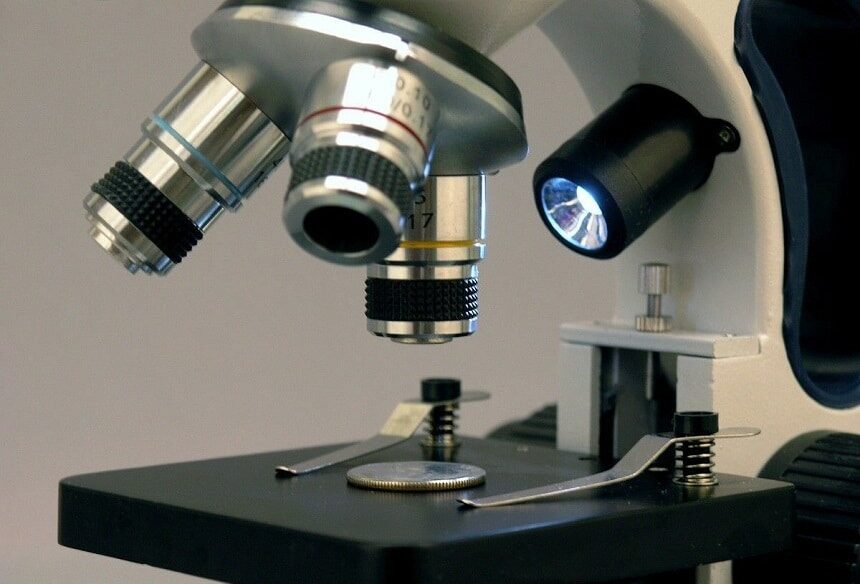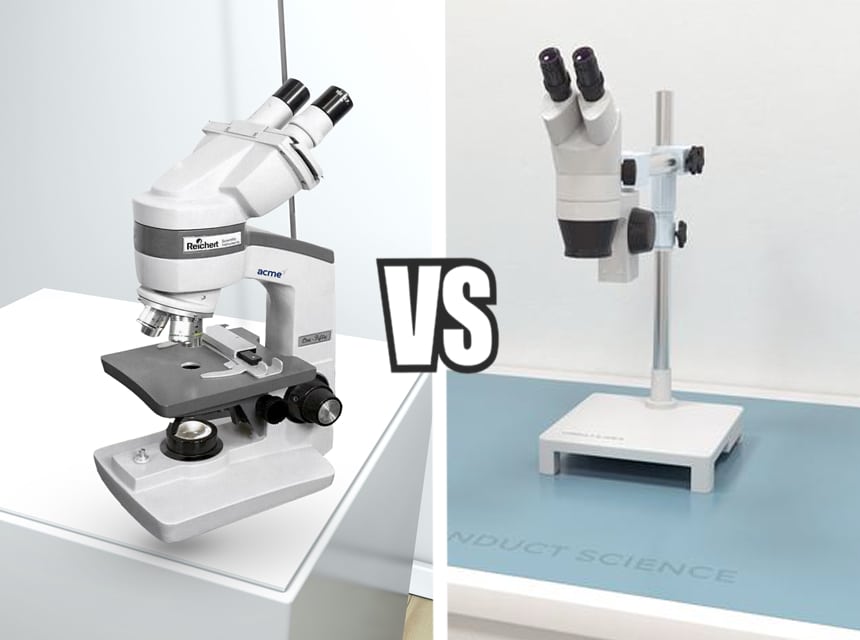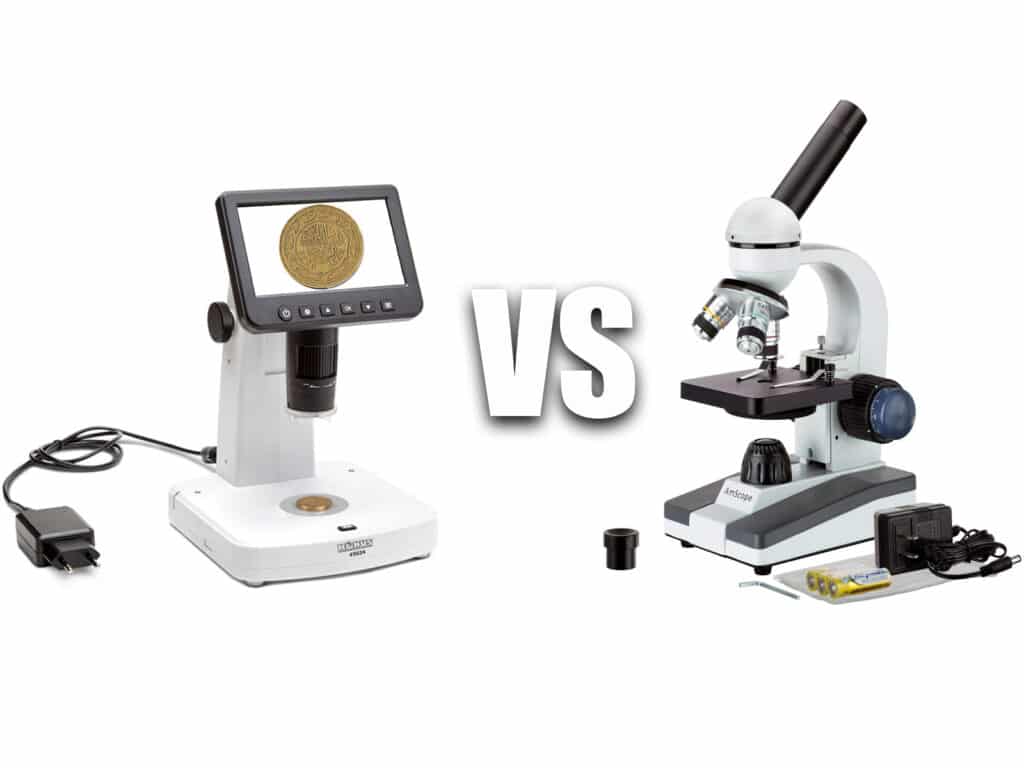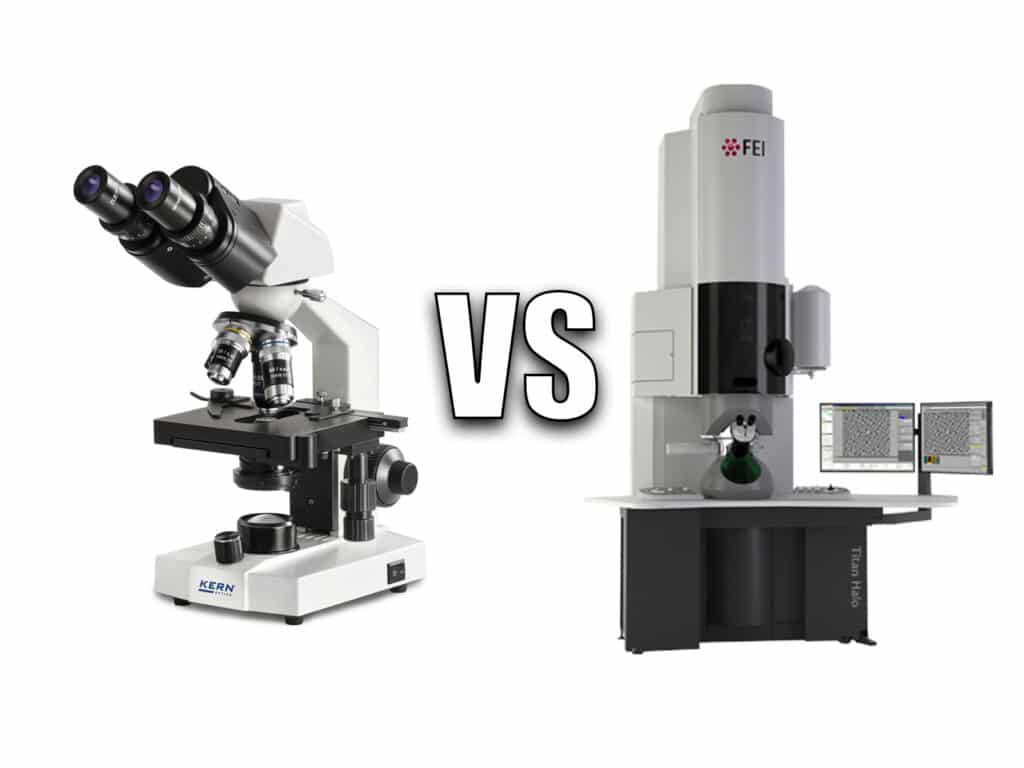

If you are not an expert in the field, it’s not easy to find the best compound microscope in the market. That is because most users don’t know where to start looking for a unit that meets their expectations. It is why we did the footwork and gathered the top-rated products currently available to make things easier for you.
The critical thing is that we left no stone unturned. We covered the basics like magnification and the swiveling head, as well as its inclination. Our team also analyzed eye and nosepieces, details about objective lenses, and the product’s durability and warranty. Finally, physical specifications, like weight and dimensions, are also important and can affect portability and stability.
Continue reading, and you will find more info about compound microscopes and how to pick them. Once you are done with the analysis, you will be able to find a suitable product. Let’s get started!
More features: coaxial coarse and fine focus, mechanical stage with adjustment handle, LED light, solid metal frame construction, comes with useful accessories
Awarded as the best compound microscope in 2016 – Omax is a truly designed gem. It’s understandable why this product has been a user favorite for years. For starters, it features durable construction with a strong metal frame. That indicates the product will last for a long time, and the five-year warranty supports that claim.
The microscope has a 2,000x maximum magnification. Next, it comes with eight different adjustments, which should be sufficient for all your requirements. You can use fine focus and coaxial coarse knobs placed on the sides. They are a bit difficult to move, but you will get used to them over time. The LED light will ensure to illuminate the working area better.
What we liked: The total magnification is impressive, and it will meet the expectations of even the most demanding users.
What could be better: The product might lose focus occasionally, which requires losing time on refocusing it.
More features: functions as a compound and stereo microscope, coarse focus, LED lights, runs on 3 AA batteries, comes with accessory kit
If you are a beginner, you want a light compound microscope available at an affordable price. What if you can get stereo and compound options in a single device? That’s what My First Lab enabled with their MFL-06 unit.
The product only weighs 2.7 pounds, and it’s easy to move around. That also makes it a bit unstable, so always place it on a flat surface. The unit has a maximum magnification of 400x, and the manufacturer used mostly plastic components for the base. It runs on batteries, and you will need 3AA units to run it.
What we liked: It includes an accessory kit with 50 different pieces, such as plain slides, slide labels, plastic dropper, and test tunes, etc.
What could be better: It’s very lightweight, which makes it a bit unstable and easy to knock over if not careful.
More features: adjustable halogen illumination with Abbe condenser and iris diaphragm, mechanical stage, all-metal construction, coaxial focus with coarse and fine focusing knobs
Celestron Labs designed a premium compound microscope with exceptional durability. It comes with a two-year warranty, but it will last longer if you maintain it right.
The product includes two eyepieces, a WP-20x and a WF-10x with a pointer. You can change these eyepieces easily to find your perfect adjustment. Thanks to that, the maximum magnification is 2,000x, which is impressive. The four-position nosepiece is convenient, and we could say the same for the adjustable mechanical stage.
You can control the focus with the fine focus and coaxial coarse knob. That gives you all the freedom you need, and the knobs are surprisingly responsive. The instruction manual could be more detailed, especially when it comes to cleaning the unit.
What we liked: The illumination options are convenient – you can activate only front and back, or go with both.
What could be better: The manufacturer doesn’t include as many accessories as expected for a premium model.
More features: 3-D double layer mechanical stage, coaxial coarse and fine focusing, Abbe condenser, iris diaphragm, and color filter, LED light with dimmer, 1.3MP camera
AmScore is another manufacturer famous for high-quality microscopes, and its B120C-E1 is not an exception. The magnification options are impressive, and you can also use a 360-degree swiveling with a 30-degree incline. That will ensure an optimal view of the item you are observing.
The 3D mechanical stage is convenient and secures impressive stability. The product includes a color filter, iris diaphragm, and the knobs for fine focus and coaxial coarse.
You won’t find many compound binocular microscopes that have a camera, but this unit includes a 1.3MP with compatible Windows software. While it doesn’t offer spectacular capabilities, it can be useful in some cases.
What we liked: The optics are excellent, and you can choose between five magnification settings, including the generous 2,500X one.
What could be better: The camera features are tricky to use because the software is unreliable, and the camera itself is quite poor.
More features: 5.0MP camera with USB port, LED light with dimmer, Abbe condenser, a mechanical stage with moveable slide holder, comes with accessory kit
Whether you are a hobbyist or a professional, you will find the Swift SW380T a convenient compound microscope to use in all situations. The product comes with two eyepieces and four achromatic lenses, including three springs and a special 100x spring and oil one.
If you want, you can observe the image on your PC. You use a USB port to connect the 5MP camera to the device and your computer. From there, it’s easy to use the software to see a live image, which is perfect for both professors and students. The product features impressive adjustment options, including a 30-degree tilt that will minimize neck strain when working with the unit for long.
What we liked: The camera is of surprisingly high quality since it features 5MP and works well with the Windows software.
What could be better: The knobs might seem a bit too sensitive, so you might need extra patience when operating them.
More features: single-lens condenser with disc diaphragm ,metal framework and built-in LED illumination, can be powered with batteries or adapter
It’s not only that AmScope is one of the best compound microscope brands, but this product deserves your attention for its fantastic features. For starters, it has two eyepieces, with the larger one being 25x, which is impressive. Although it comes with only three objectives, that should be sufficient for most users.
The product includes a five-year warranty, a dust cover, and an adapter for powering the unit. Also, you can use batteries, but it’s necessary to buy them separately. The integrated illumination is impressive, and the maximum magnification is 1,000x. Finally, the 45-degree inclination is not that often in the market, which is why this might be the gem you always wanted.
What we liked: Unlike some other units, the product features a 45-degree inclined head, which is great if that’s what you need.
What could be better: The product is light, which is why you need to be careful not to knock it down accidentally.
More features: fine and coarse focusing, diopter, LED light, mechanical stage and movable slide holder, adjustable working distance
If you don’t mind a few extra pounds, you will love the stability and durability offered by Barska’s microscope. It is a binocular unit that offers an adjustable working distance, which is convenient. The product also comes with a 45-degree inclined head, and four objective lenses are also impressive.
You will find the manufacturer used copper and aluminum alloy for the housing, which ensures optimal durability. The box comes with two eyepieces – WF10 and WF20x. As for the microscope, you will find knobs for coarse and fine adjustments and an adjustable slide holder. Overall, it delivers plenty of bang for the buck.
What we liked: The 20W halogen light is impressive, and multiple adjustments ensure you always find an optimal brightness level.
What could be better: The durability doesn’t seem to be the strongest suit of this microscope, and you don’t get a generous warranty.
More features: LED illumination, built-in eyepiece pointers, Abbe condenser, coaxial coarse and fine focusing
According to our compound microscope reviews, Vision Scientific’s device is another product worth considering. The first thing you will notice is that the microscope is light, which makes it very portable. But that could affect overall stability, so be careful where you position it.
The microscope features a low-profile stage, and it’s easy to position items on it. You will find a single eyepiece and four achromatic objective lenses. The maximum magnification is 1,000x, which is in the medium capacity range.
Next, the illumination is adjustable and long-lasting, which simplifies using the unit. It’s nice to see the manufacturer offering a 5-year warranty. The company is a reputable brand in the compound microscope market, which is another reason to trust it.
What we liked: It’s nice that you can adjust the intensity of the light, which ensures that you can pick the right illumination level.
What could be better: It seems like the instruction manual could provide more details on how to use the product.
More features: LED illumination, Abbe condenser, coarse and fine focus adjustment, comes with dust cover and rubber eye guards
The first thing you notice about this Meiji Techno compound microscope is that its design isn’t that attractive. It features a classic appearance, but the important thing is it delivers decent performance if you scratch under the surface.
You can enjoy multiple achromatic lenses, including a 60x one. The magnification capabilities could be higher, but they should cover most student requirements. It’s possible to use fine focus and coarse knobs to adjust the desired position. The manufacturer secured everything you need to extend the microscope’s longevity. That includes rubber eye guards and a dust cover. The product even comes with its own illumination, and that will ensure you have a better view of the samples.
What we liked: The ease of use and durability ensure the product is suitable for schools and frequent use.
What could be better: The overall magnification capabilities aren’t that impressive at this price range.
More features: coaxial coarse and fine focusing, LED illumination, a plain stage with stage clips, can run with batteries or adapter, disc diaphragm, comes with extra bulb and dust cover
Here is another compound microscope that we would consider an entry-level device for anyone looking for an affordable deal. The manufacturer used a combination of metal, plastic, and glass materials. The color choice is interesting and modern.
As for the performance, this is a monocular microscope, so make sure that it’s the type you need. It comes with a rotatable nosepiece and LED illumination, but it only includes a single eyepiece. The device is versatile as you can power it using both batteries and electricity. On top of that, it comes with a one-year warranty, but it’s fairly durable. You can move it around since it weighs less than six pounds, and that ensures it remains quite stable.
What we liked: You can use both batteries and electricity to power the unit, which makes it surprisingly portable.
What could be better: Unlike some other units mentioned in our reviews, this product only comes with a single eyepiece.
Whichever product you buy, it’s vital to learn about it before making the final decision. That is why we prepared a detailed buying guide on compound microscopes and their design and performance features. Our experts will reveal the benefits of using these devices but also consider the factors to take into account during the selection process. We will even answer the most commonly asked questions asked by the community so that you have all the information. If you are ready, let’s start and see what you need to know about compound microscopes!
If you decided that you need a microscope, you might still be in a dilemma whether a compound device is the right pick. Now, let’s take a look at the reasons why you should go with a compound microscope:

Are you having problems discovering where to start when choosing a compound microscope? You’ve come to the right place because we gathered the crucial features of these products and analyzed them to the smallest detail. We will talk about their performance, including magnification and observation capabilities. Apart from that, our experts also discussed the ease of use and other factors, such as portability. The idea was to offer comprehensive information to simplify your selection process. Here are the crucial factors to consider!
We will start with arguably the crucial feature of a microscope – magnification. These capabilities directly decide which specimens you can observe under the device. Now, compound microscopes usually have a large magnification, which can go up to 2,500x. For example, the OMAX LED Binocular Compound Lab Microscope has 40-2,500x variable settings, which ensures you can find the perfect magnification for any specimen.
Depending on your needs, a 1,000x might be sufficient, especially if the product offers varying magnifying capabilities. That is why you should consider the specimens you plan to observe. It is always smart to have more options and as big magnification as possible, although you should make sure it fits your budget.
If you check out how compound microscopes look, you will find them in two different variations – monocular and binocular. As the words suggest, a monocular is the one you observe through with a single eye, while binoculars allow observing with both eyes simultaneously. Each method has its own benefits, so make sure to pick based on your preference.
Apart from the type, it’s vital to consider the inclination of the head. The two most common options are 30 and 45-degree incline. For example, the Meiji Techno MT-12 is a monocular microscope with a 45-degree head. Still, 30-degree options are more common in the market. It would be best if you could try both options to see which one fits your needs better.
Eyepieces and objective lenses are two other components vital for providing a high-quality image. Apart from keeping them clean, it’s vital to pick suitable ones for your needs. We also know eyepieces as ocular lenses, and their name comes from the fact that they are the ones located near to your eyes. Eyepieces might come in 5x-50x versions, but the most frequent ones are 10-20x.
Objective lenses have the task of gathering light and provide you with a crisp image when using a compound microscope. You will often find achromatic lenses, such as in the C & A Scientific Premiere MS-01L. It’s not uncommon to pick between multiple lenses on a revolving nosepiece. These could vary somewhere from 10x to 400x, so pick based on your needs.
Here is an interesting thing to consider – does your compound microscope have a light source? These products are using additional features to simplify and improve the user experience. That is why most devices are equipped with LED illumination. Its main benefit is to illuminate the working area and secure a clear view of the desired specimen.
The reason why LED lights are a smart choice is that these bulbs can last thousands of hours, and much more than conventional units. You can benefit from a product with adjustable brightness level, such as the Vision Scientific VME0007B-100-LD Binocular Compound Microscope. That way, you will find ensure a clear view that’s not too bright or dark.
Do you plan on moving your microscope frequently? Would you like a unit to use at work but also take home? If that is the case, go with a lightweight product like the AmScope M100C-LED. These devices weigh less than 4-5 pounds, and that makes them easy to carry around. The problem is they don’t offer generous stability, which is why you should be careful where to position and how to use them. If you go with a heavier unit, you get additional stability but make the product less portable. A microscope that weighs 12 pounds can be extremely stable and still fairly easy to move around, so it all depends on your preference.
As for the size, microscopes can be anywhere from 15 x 7 x 10 inches to 25 x 15 x 20 inches or larger. That’s why you should check the product description and see if the dimensions fit your expectations. The general rule is that smaller units are easier to move.
You have plenty to consider when it comes to adjustability. First, you want to check the control knobs located on the product’s sides.
Most microscopes will include both a coaxial coarse and fine focus. You can use these knobs to find the perfect adjustment easily. Just make sure the knobs’ responsiveness is optimal – you want to move them effortlessly and also keep the chosen setting for as long as necessary.
Another adjustable option is usually the mechanical stage that comes with a compound microscope. In some units, you can position the slide holder, too. All that gives you additional freedom to find the optimal setting for your needs. If you are looking for an adjustable working distance, go with the BARSKA AY13074 40x-2000x Binocular Compound Microscope or similar units.
Your microscope needs a power source to run, and the applicable sources depend on the unit. Some can only use a cable, while others require only batteries. But some manufacturers will provide both options and leave the user to choose from. That is the most suitable option if you need a portable unit to carry around frequently, and it’s why you should consider the C & A Scientific Premiere MS-01L or similar products.
The AC adapter will usually come with the microscope, but make sure to check the voltage. Depending on your location, you will need either a 110V or 220V adapter. As for batteries, some units use 3AAA batteries, but don’t forget to go through the product description to ensure you buy ones that fit with your device.
Cameras are an optional feature in compound microscopes, which is why not many devices have it. It’s vital to note that the camera resolution is often not that impressive, especially if you compare it to smartphones. But the main benefit of these cameras is to observe the image on the computer, which helps more people to see it at once. You can also capture the footage to store it.
The basic cameras have around 1MP, while you will also find stronger cameras like the 5MP one in the Swift SW380T. While the general rule is the higher, the better, even modest resolutions should be sufficient for most users who require this feature.
While accessories aren’t a mandatory part for a compound microscope to have, it’s nice when the manufacturer adds an extra kit for the users. These kits usually include multiple pieces, which can vary from 10 to 100. For example, the My First Lab Duo-Scope Microscope – MFL-06 offers a 50-piece kit with a variety of components.
The basic parts of these kits are often plain slides, but you can also expect a slide label, plastic dropper, teasing needle, and other units. We shouldn’t miss mentioning eye guards and dust covers, which can simplify the cleaning process and extend the product’s longevity.
Here is the crucial thing to note – you will rarely find a new compound microscope that doesn’t come with a warranty. But the guaranteed time might vary significantly. The shortest warranty period is usually 12 months, and that’s applicable to entry-level units and bargain deals, while some manufacturers offer a five-year guarantee. Those include products like the AmScope B120C-E1, which were made to last for years and deliver consistent performance.
As long as you stick to reputable compound microscope brands, you can be sure they will honor the warranty if anything goes wrong. That means you will have peace of mind while the guarantee is active.
The OMAX 40X-2500X LED Binocular Compound Lab Microscope is our top choice for a compound microscope. It is an award-winning device that comes with a swiveling head, revolving nosepiece, integrated illumination, and a generous warranty. Apart from that, the frame construction ensures the required stability, and you get an entire set of useful accessories.
The My First Lab Duo-Scope Microscope – MFL-06 is another excellent pick, which is a true bargain deal. It comes with a fixed head and a single eyepiece, as well as an accessory kit that will help you get started. Overall, it ensures plenty of bang for the buck at this price range.
Lastly, the Celestron Labs CB2000C Compound Trinocular Microscope can be the best compound microscope for all those that don’t mind investing a couple of extra dollars. It offers generous magnifications and supports the viewing of prepared slides and 3D objects.
You can also pick microscopes with cameras, but the important thing is to look for the features that meet your expectations. That will ensure the product is the best fit for you!





